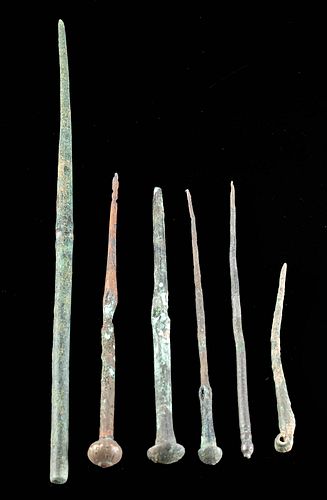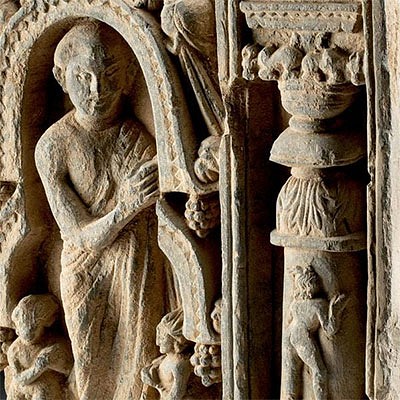6 Roman & Luristan Bronze & Copper Pins
Lot 71
About Seller
Artemis Gallery
686 S Taylor Ave, Ste 106
Louisville, CO 80027
United States
Selling antiquities, ancient and ethnographic art online since 1993, Artemis Gallery specializes in Classical Antiquities (Egyptian, Greek, Roman, Near Eastern), Asian, Pre-Columbian, African / Tribal / Oceanographic art. Our extensive inventory includes pottery, stone, metal, wood, glass and textil...Read more
Categories
Estimate:
$500 - $750
Absentee vs Live bid
Two ways to bid:
- Leave a max absentee bid and the platform will bid on your behalf up to your maximum bid during the live auction.
- Bid live during the auction and your bids will be submitted real-time to the auctioneer.
Bid Increments
| Price | Bid Increment |
|---|---|
| $0 | $25 |
| $300 | $50 |
| $1,000 | $100 |
| $2,000 | $250 |
| $5,000 | $500 |
| $10,000 | $1,000 |
| $20,000 | $2,500 |
| $50,000 | $5,000 |
| $100,000 | $10,000 |
| $200,000 | $20,000 |
About Auction
By Artemis Gallery
Sep 16, 2021
Set Reminder
2021-09-16 10:00:00
2021-09-16 10:00:00
America/New_York
Bidsquare
Bidsquare : Ancient & Ethnographic Art Through The Ages
https://www.bidsquare.com/auctions/artemis-gallery/ancient-ethnographic-art-through-the-ages-7473
Ancient art from Egypt, Greece, Italy and the Near East, as well as Asian, Fossils, Pre-Columbian, Native American, African / Tribal / Oceanic, Fine art, and much more! All categories, all price ranges... all legally acquired and guaranteed to be as described or your money back. Artemis Gallery info@artemisgallery.com
Ancient art from Egypt, Greece, Italy and the Near East, as well as Asian, Fossils, Pre-Columbian, Native American, African / Tribal / Oceanic, Fine art, and much more! All categories, all price ranges... all legally acquired and guaranteed to be as described or your money back. Artemis Gallery info@artemisgallery.com
- Lot Description
Near East, Turkey & Northwestern Iran, Luristan, ca. 1000 BCE to 600 BCE; Roman, Imperial Period, ca. 1st to 3rd century CE. A collection of 6 bronze and copper pins for securing clothing and hair. All have similar profiles, with a tapering rod or needle-shaped body and a finial head. The longest pin is missing the head, but perhaps had a stone finial attached to the top of lapis lazuli or another semi-precious stone. Before the Roman fibula became widespread, straight pins in Luristan culture - such as this large example - were used for securing cloaks and clothing. The other 5 pins have flared spherical finials and one has a curled tip that forms a suspension loop. These pins were perhaps used as hairpins to secure the elaborate hairstyles of Roman women. The pieces made of bronze and other precious metals were luxury items for the wealthy and were buried in graves to accompany their owners to the afterlife. Size of longest: 8.25" L x 0.25" W (21 cm x 0.6 cm); shortest: 3.125" L x 0.2" W (7.9 cm x 0.5 cm)
Provenance: ex-estate of John Piscopo, San Diego, California, USA, 1990's or earlier. Mr. Piscopo was one of the largest collectors of ancient weapons in the US with a collection that spanned all cultures, all ages.
All items legal to buy/sell under U.S. Statute covering cultural patrimony Code 2600, CHAPTER 14, and are guaranteed to be as described or your money back.
A Certificate of Authenticity will accompany all winning bids.
PLEASE NOTE: Due to recent increases of shipments being seized by Australian & German customs (even for items with pre-UNESCO provenance), we will no longer ship most antiquities and ancient Chinese art to Australia & Germany. For categories of items that are acceptable to ship to Australia or Germany, please contact us directly or work with your local customs brokerage firm.
Display stands not described as included/custom in the item description are for photography purposes only and will not be included with the item upon shipping.
#116773Losses to finial head of largest pin. Losses to surface layers and surface pitting. Perforations and losses to pin rods. Bending of forms. Heavy green patina and mineral deposits.Condition
- Shipping Info
-
All shipping is handled in-house for your convenience. Your invoice from Artemis Gallery will include shipping calculation instructions. If in doubt, please inquire BEFORE bidding for estimated shipping costs for individual items.
-
- Buyer's Premium



 EUR
EUR CAD
CAD AUD
AUD GBP
GBP MXN
MXN HKD
HKD CNY
CNY MYR
MYR SEK
SEK SGD
SGD CHF
CHF THB
THB











